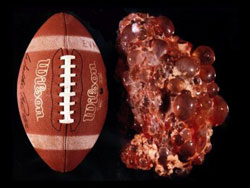Common diabetes drug may halt growth of cysts in polycystic kidney disease

At left, a regulation size football. At right, a human cystic kidney removed during a transplantation operation. A normal human kidney is the size of an adult fist. Credit: Andrew P. Evan, Ph.D., Department of Anatomy and Cell Biology, Indiana University School of Medicine<br>
Researchers from the schools of Science and Medicine at Indiana University-Purdue University Indianapolis and colleagues from the Mayo Clinic report this month in the online peer-reviewed journal PPAR Research that pioglitazone appears to control the growth of PKD cysts.
Using a rat model that has the same genetic mutation as a form of human PKD, the two research groups independently tested a pioglitazone treatment regimen and found that it slowed down both kidney and liver cyst growth by inhibiting a chloride channel in the cells of these organs.
Normally pioglitazone works by making the body more sensitive to its own insulin. However, in studying why this class of drugs causes fluid retention, Bonnie L. Blazer-Yost, Ph.D., professor of biology at the IUPUI School of Science and corresponding author of the new study, serendipitously found that it also inhibits a chloride channel.
“We thought that since this class of drugs inhibits the body's chloride channels, then it would be a good candidate to treat PKD, a disease in which excessive chloride and water are transported into the cysts of the kidneys and the liver causing them to expand,” said Blazer-Yost, Ph.D.
A normal kidney is the size of a fist. A polycystic kidney is the size of a football. Currently there is no cure for PKD and therapy options are limited. Organ transplantation is the most common treatment.
“The idea of using a chloride channel inhibitor to treat PKD is not new. What is new is our finding that an insulin sensitizing agent like piogltiazone inhibits chloride channels. The finding that pioglitazone, which has already been approved by the Food and Drug Administration for diabetes, can halt cyst progression and may be an effective and well-tolerated treatment for this chronic disease, is exciting. Confirmation of these results in other animal models of PKD would be a useful next step.
“We know from long-term experience that this drug has a good safety profile. Strategies that minimize adverse events are important when considering treatments for a chronic disease such as PKD,” said Blazer-Yost, a physiologist who hopes that human trials of pioglitazone therapy for PKD can be conducted in the near future.
In addition to Blazer-Yost, who is also an adjunct professor of cellular and integrative physiology and of anatomy and cell biology at the IU School of Medicine, authors of “Pioglitazone Attenuates Cystic Burden in the PCK Rodent Model of Polycystic Kidney Disease” are Julie Haydon of IUPUI's School of Science; Tracy Eggleston-Gulyas, Jey-Hsin Chen, M.D., Ph.D., and Vincent Gattone, Ph.D., of the IU School of Medicine; Xiaofang Wang, Ph.D., and Vicente E. Torres, M.D., Ph.D., of the Mayo Clinic.
The studies at IUPUI were funded by an IUPUI Research Support Fund Grant. The studies at the Mayo Clinic were supported by funds from Takeda Pharmaceuticals North America, Inc.
The School of Science at IUPUI is committed to excellence in teaching, research, and service in the biological, physical, behavioral and mathematical sciences. The School is dedicated to being a leading resource for interdisciplinary research and science education in support of Indiana's effort to expand and diversify its economy. For more information visit www.science.iupui.edu
Media Contact
More Information:
http://www.iupui.eduAll latest news from the category: Health and Medicine
This subject area encompasses research and studies in the field of human medicine.
Among the wide-ranging list of topics covered here are anesthesiology, anatomy, surgery, human genetics, hygiene and environmental medicine, internal medicine, neurology, pharmacology, physiology, urology and dental medicine.
Newest articles

Trotting robots reveal emergence of animal gait transitions
A four-legged robot trained with machine learning by EPFL researchers has learned to avoid falls by spontaneously switching between walking, trotting, and pronking – a milestone for roboticists as well…

Innovation promises to prevent power pole-top fires
Engineers in Australia have found a new way to make power-pole insulators resistant to fire and electrical sparking, promising to prevent dangerous pole-top fires and reduce blackouts. Pole-top fires pose…

Possible alternative to antibiotics produced by bacteria
Antibacterial substance from staphylococci discovered with new mechanism of action against natural competitors. Many bacteria produce substances to gain an advantage over competitors in their highly competitive natural environment. Researchers…





















